Catalogue > List by artist
Browse the entire list of Rencontre Internationales artists since 2004. Use the alphabetical filter to refine your search. update in progress
Naïmé Perrette
Catalogue : 2016Forebear Forward | Video | hdv | color | 1:8 | France, Netherlands | 2014
Naïmé Perrette
Forebear Forward
Video | hdv | color | 1:8 | France, Netherlands | 2014
En mêlant mémoires familiales et images collectées sur internet, Forebear Forward et Work Hard Play Hard jouent sur le décalage entre des événements et leurs récits. Au premier plan, un grand-père relate des faits vécus par ses aïeux, accompagné par les commentaires de sa femme en hors-champs. Leurs échanges et l`arrière plan d`images d`archives ou de Google Street View se superposent aux histoires, accordant ainsi plus d`importance au contextes de narrations qu`à leurs sujets. Ces réappropriations de récits commentent avec humour le décalage générationnel, l`appartenance sociale, et le passage du drame à l`anecdote. Dans Forebear Forward,le grand-père se concentre sur une anecdote individuelle cocasse ayant eu lieu lors d`une dramatique explosion, tandis que sa femme désire surtout connaître le bilan des morts et rentrer chez elle. De son côté, la vidéaste invoque google pour inscrire cette histoire dans ses outils quotidiens de compréhension. Pour commenter le décalage social entre des matelots embarqués contre leur gré et le ton bourgeois et relativiste de ceux qui livrent ce récit, Work Hard Play Hard utilise des images de culturistes observés par le public comme s`ils étaient étrangers à leur propre espèce.
Cesar Pesquera
Catalogue : 2011Círculo Uno | Experimental fiction | | color | 20:30 | Spain | 2010
Cesar Pesquera
Círculo Uno
Experimental fiction | | color | 20:30 | Spain | 2010
René lives a dull, uneventful life in a subterranean and futuristic world. He is about to be promoted and transferred from Circle One to Circle Six, when a series of mysterious mounds start to appear systematically in his apartment. Circle one`s starting point is Dante?s Divine Comedy combining the notion of Michael Haneke?s thriller with Andrei Tarkovski?s intimacy, albeit clearly influenced by pioneering movie directors like Stanley Kubrick or George Lucas.
César Pesquera is a director, graphic designer and audiovisual artist. He has directed and designed innovative moving image work across a broad spectrum of both commercial and non-commercial strands of the visual arts. His work is a reflection on the grammar of cinema and the relation between visual art and the cinematic experience. His films are screened worldwide on both visual art platforms and film festivals.
Cesar Pesquera Muro
Catalogue : 2007Passer/8 | Experimental doc. | dv | color | 15:0 | Spain | 2006
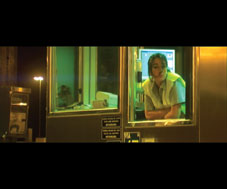
Cesar Pesquera Muro
Passer/8
Experimental doc. | dv | color | 15:0 | Spain | 2006
"Passer/8" is an experimental project about two real people, a girl that works in a tollbooth and a guy that owns a carrousel. The project deals with issues such as constant movement and stillness, the activities mentioned above being metaphors of such concepts, so much related to life or any other processual phenomena - whether vital or creative.
César Pesquera has shown his work at various festivals and international events such as A/V Festival 2006 (Sunderland, UK), Resfest Spain (Art Futura 2005, Barcelona, España), Optronica 2005 (London, UK), Dotmov 2004 (Sapporo, Japan), The eighth Rencontres Internationales Paris/Berlin 2004, VIPER 2002 International Festival for Film Video and New Media (Basel, Switzerland), Observatori 2002 and 2003, the third International Festival of Artistic Research of Valencia, Art Futura 2001, the Art and New Technologies Festival (Barcelona, Spain), Transmissions Festival 004 (Chicago, USA), and SONAR 2001, 2004 and 2005 (Barcelona, Spain). He has also shown his work in exhibitions such as Digital Showcase #31, AMOADA, the Austin Museum of Digital Art in Texas (USA); Projectionsareal, ZKM, Zentrum für Kunst und Medientechnologie, Karlsruhe (Germany); This Is Not My Computer, DA2 Museum Of Contemporary Art (Salamanca, Spain); and ZooRoom. A Room with a View. Resistor Galery (Toronto, Canada). Cesar Pesquera is currently working as a director of commercials and music videos. He is also the co-founder of Actop, a studio operating as an open structure and working on a wide range of media: Print, Animation, Motion Graphics, Live Visuals and new approaches to the moving image. He has recently finished his first short film "Passer/8" and is currently collaborating with the British collective "D-Fuse" on different projects. He is also the Associate Director of Rojo®Magazine and Art Director of Ruga®Magazine, a DVD magazine distributed internationally, aiming to show unreleased audiovisual works by artists worldwide. As Shudo, Cesar Pesquera has released two albums on the prestigious Belgian label "Sub Rosa/Quatermass". He is now working on a new project under the alias Portabot.
Axel Petersén, in co-operation with Arild Andersson
Catalogue : 2013Like Father, Like Son, Like Michael Douglas | Video | hdv | color | 11:30 | Sweden | 2012
Axel PetersÉn
Like Father, Like Son, Like Michael Douglas
Video | hdv | color | 11:30 | Sweden | 2012
In Paul Verhoevens erotic thriller Basic Instinct from1992, Michael Douglas character is put to the test. Is he still living up to the image of his own sexuality? Is he still the sex symbol Michael Douglas, son to the former sex symbol Kirk Douglas? In Like Father, Like Son, Like Michael Douglas Axel Petersén is staging a sexual generation shift. Through a number of scenes he instructs his father, Etienne Petersén to play the main male character while he himself portrays the female counterparts - a father and a son together watching and acting Basic Instinct.
Axel Petersén, born in Stockholm 1979, is a visual artist and filmmaker. He has made feature film (1), short films and video installations that have been shown widely in art and film contexts. He has a MFA from The Royal Institute of Art, Stockholm; he also studied film at FAMU, Academy of Performing Arts in Prague and most recently attended the Mountain School of Arts in Los Angeles.
Catalogue : 2011The Tracks of my Tears | Art vidéo | 0 | color | 10:0 | Sweden, Iraq | 2010
Axel PetersÉn, in co-operation with Arild Andersson
The Tracks of my Tears
Art vidéo | 0 | color | 10:0 | Sweden, Iraq | 2010
Saddam Hussein?s palace is looted in Baghdad 2003. A red Ferrari Testarossa disappears from his garage. Years pass by and cars from the same garage are found around the world; some crashed, some in mint condition. The Testarossa is still out there, ghostriding through the neverending desert.
Axel Petersén, born in Stockholm 1979, is a story teller and a visual artist. Educated at FAMU, Academy of Performing Arts in Prague and took his MFA at KKH, the Royal Institute of Art in Stockholm.
Catalogue : 2010close to god / far from home | Documentary | dv | color | 11:7 | Sweden, Palestine | 2009
Axel PetersÉn
close to god / far from home
Documentary | dv | color | 11:7 | Sweden, Palestine | 2009
Close to God / Far from Home (Somewhere in between pop and classical) is a portrait of a place and a state, stuck in between and surrounded by barriers. Close to God / Far from Home is High Class Salon and it?s owner; Palestine`s loneliest lover Tony, hair-dresser and choir-boy. Mr Tony is a proud decendant of Italian 13th century cruisaders and a natural born Germanophile. Mr Tony is also the sexiest man in Bethlehem, forever faithful to Jesus Christ, Richard Clayderman and Kaiser Franz Joseph to whom he built a temple, an altar, a home.
Axel Petersén is a visual artist born in Sweden 1979. He was educated in film at FAMU, Academy of Performing Arts i Prauge and in fine arts at the Royal Academy of Fine Arts in Stockholm. Axel Petersén makes videos, video-installations, still and moving image portraits and block buster movies for the cinema. Axel Petersén works with both ?fiction? and ?documentary?, usually merging the two in to a form were he can take on an active part, and by doing so, being able to push the scenes in the right, or the wrong direction. Right now he?s working on a feature length fiction film; After Eigh, a thrillerish manifestation to the grown-ups that never grew up.
Catalogue : 2009Slumber past Zenith | Fiction | | | 17:5 | Sweden, Egypt | 2007

Axel PetersÉn
Slumber past Zenith
Fiction | | | 17:5 | Sweden, Egypt | 2007
At Hotel Alexandria in Alexandria Europe is dying slowly; George has Alzheiemers, Sami is busy arranging the farewell party and the gravedigger Salah is helping Madame with her last preparations for her final journey.
History of Arts in Stockholm & Lund University. Sweden FAMU Academy of Performing Arts in Prague, Czech Rep. KKH, Royal University College of Fine Arts Stockholm, Sweden. Male, born -79.
Axel Petersén
Catalogue : 2013Like Father, Like Son, Like Michael Douglas | Video | hdv | color | 11:30 | Sweden | 2012
Axel PetersÉn
Like Father, Like Son, Like Michael Douglas
Video | hdv | color | 11:30 | Sweden | 2012
In Paul Verhoevens erotic thriller Basic Instinct from1992, Michael Douglas character is put to the test. Is he still living up to the image of his own sexuality? Is he still the sex symbol Michael Douglas, son to the former sex symbol Kirk Douglas? In Like Father, Like Son, Like Michael Douglas Axel Petersén is staging a sexual generation shift. Through a number of scenes he instructs his father, Etienne Petersén to play the main male character while he himself portrays the female counterparts - a father and a son together watching and acting Basic Instinct.
Axel Petersén, born in Stockholm 1979, is a visual artist and filmmaker. He has made feature film (1), short films and video installations that have been shown widely in art and film contexts. He has a MFA from The Royal Institute of Art, Stockholm; he also studied film at FAMU, Academy of Performing Arts in Prague and most recently attended the Mountain School of Arts in Los Angeles.
Catalogue : 2011The Tracks of my Tears | Art vidéo | 0 | color | 10:0 | Sweden, Iraq | 2010
Axel PetersÉn, in co-operation with Arild Andersson
The Tracks of my Tears
Art vidéo | 0 | color | 10:0 | Sweden, Iraq | 2010
Saddam Hussein?s palace is looted in Baghdad 2003. A red Ferrari Testarossa disappears from his garage. Years pass by and cars from the same garage are found around the world; some crashed, some in mint condition. The Testarossa is still out there, ghostriding through the neverending desert.
Axel Petersén, born in Stockholm 1979, is a story teller and a visual artist. Educated at FAMU, Academy of Performing Arts in Prague and took his MFA at KKH, the Royal Institute of Art in Stockholm.
Catalogue : 2010close to god / far from home | Documentary | dv | color | 11:7 | Sweden, Palestine | 2009
Axel PetersÉn
close to god / far from home
Documentary | dv | color | 11:7 | Sweden, Palestine | 2009
Close to God / Far from Home (Somewhere in between pop and classical) is a portrait of a place and a state, stuck in between and surrounded by barriers. Close to God / Far from Home is High Class Salon and it?s owner; Palestine`s loneliest lover Tony, hair-dresser and choir-boy. Mr Tony is a proud decendant of Italian 13th century cruisaders and a natural born Germanophile. Mr Tony is also the sexiest man in Bethlehem, forever faithful to Jesus Christ, Richard Clayderman and Kaiser Franz Joseph to whom he built a temple, an altar, a home.
Axel Petersén is a visual artist born in Sweden 1979. He was educated in film at FAMU, Academy of Performing Arts i Prauge and in fine arts at the Royal Academy of Fine Arts in Stockholm. Axel Petersén makes videos, video-installations, still and moving image portraits and block buster movies for the cinema. Axel Petersén works with both ?fiction? and ?documentary?, usually merging the two in to a form were he can take on an active part, and by doing so, being able to push the scenes in the right, or the wrong direction. Right now he?s working on a feature length fiction film; After Eigh, a thrillerish manifestation to the grown-ups that never grew up.
Catalogue : 2009Slumber past Zenith | Fiction | | | 17:5 | Sweden, Egypt | 2007

Axel PetersÉn
Slumber past Zenith
Fiction | | | 17:5 | Sweden, Egypt | 2007
At Hotel Alexandria in Alexandria Europe is dying slowly; George has Alzheiemers, Sami is busy arranging the farewell party and the gravedigger Salah is helping Madame with her last preparations for her final journey.
History of Arts in Stockholm & Lund University. Sweden FAMU Academy of Performing Arts in Prague, Czech Rep. KKH, Royal University College of Fine Arts Stockholm, Sweden. Male, born -79.
Dirk Peuker, Bettina NÜRNBERG
Catalogue : 2020Elephant Bearing an Obelisk | Experimental doc. | 16mm | color | 14:0 | Germany | 2018
Dirk Peuker, Bettina Nürnberg
Elephant Bearing an Obelisk
Experimental doc. | 16mm | color | 14:0 | Germany | 2018
Marbled paper blue, a book’s illustrations, the flicker of film’s materiality: these are just a few of the narrative devices that punctuate Bettina Nürnberg and Dirk Peuker’s essayist film tracing the atmospheric efects of Italian architect Carlo Scarpa’s significant buildings, including the Brion family cemetery. As homage the work continues the filmmakers’ interests in documenting architectural histories. What is significant about this more poetic rendering is how it follows the rhythm of the spatial forms and motifs of their subject: Scarpa took an apolitical stance and refused to make architecture during the reign of fascism in Italy (1922–43); in the years that followed however, he produced Venice’s modernist exemplars, arguably the most beautiful architectural works of modernism for how they create mental spaces embedded in and indebted to his phenomenal city. With awareness of their medium, Nürnberg and Peuker capture both the structure and freeforming style of Scarpa’s architecture: their camera is equally focused on the mood of the city, the flow of water, the mandala as dichotomous form—light casts shadows. In turn, the film oscillates between document and experimental realism. The punctuating book pages that were an inspiration for Scarpa and ofer a structuring means for the sensuality of the recorded images come from the Venetian treatise of 1499 ascribed to Poliphili, which loosely acts an inventory of life-forms and classical humanist thought while following the story of courtly love. The act of ceremony is important to the book and so it is to the film as it mediates on Scarpa’s constructions, anachronistic zones that cross life with death, only to return to life once more: the film flickers, the paper is left wet, a hand all blue rises from the ruins … (Laura Preston)
Bettina Nürnberg www.bettinanuernberg.de Bettina NÜRNBERG (1976, Germany) was educated in art and film in Hamburg and Berlin. The work of the Berlin-based artist has been screened and exhibited worldwide. Dirk Peuker www.dirkpeuker.de Dirk PEUKER (1970, Germany) studied film and art in Berlin and Vienna. The work of the experimental filmmaker and artist has been screened and exhibited worldwide.
Catalogue : 2013Flat Roofs for Mussolini | Experimental doc. | 16mm | color | 20:0 | Germany, Italy | 2012
Dirk Peuker, BETTINA NÜRNBERG
Flat Roofs for Mussolini
Experimental doc. | 16mm | color | 20:0 | Germany, Italy | 2012
The experimental film work ?Flat Roofs for Mussolini? talks about the Italien Rationalism and Fascist architecture at Lake Como and the buildings by Guiseppe Terragni, who was an important pioneer of this style and tried to persuade the fascist regime to adopt his architecture as an official style. During a creative period lasting only 13 years, Terragni produced a body of work unique in terms of consistency and density. His buildings conform to the modern and are characterised by a reduction to elementary geometrical basic forms. While his buildings now serve as an important reference for architects such as Peter Eisenmann, they are also glorified and their political dimension is downplayed. (Text by Magdalena Magiera)
Dirk Peuker born 1970 in Friedrichroda, Germany, lives and works in Berlin. He studied Experimental Film at the university of the Arts Berlin since 2009 he teaches Film & Video at the Berlin Weißensee academy of art. 2006 Residency grant at the Villa Minimo, Hannover 2007 DAAD travel grant 2008 postgraduate grant of the Free State of Thuringia, 2009 NaFöG grant by the Berlin City Council Bettina Nürnberg born 1976 in Mannheim, Germany, lives and works in Berlin. She studied Film at the University of Fine Arts Hamburg 2006-07 Funding for woman artists 2008 Film Culture Fund of the Free State of Thuringia 2009 Stiftung Kunstfonds, artist fund
Catalogue : 2011Die Amerikanischen Häuser | Experimental doc. | 16mm | color | 20:0 | Germany | 2010
Dirk Peuker, Bettina NÜRNBERG
Die Amerikanischen Häuser
Experimental doc. | 16mm | color | 20:0 | Germany | 2010
The film ?The American Houses? examines the buildings of the nearly forgotten german architect, Thilo Schoder. Schoder, who had studied under Henry van de Velde in Weimar, was classified as an architect of ?The New Objectivity? movement of the 1920s. Schoder built only a few houses in the 8 years period, from 1923 to 1931, in small villages from eastern Germany to the Czech Republic. When the Nazis took power Schoder, accused of being a socialist, was refused any further building contracts, forcing him to emigrate to Norway. In ?The American Houses? the condition of the buildings filmed range from highly renovated to abandoned and dilapidated. The surviving examples are not portrayed as technical depictions, but as subjective sensation.
Dirk Peuker born in 1970 2000-2005 University of Arts Berlin, Master of Fine Arts, Experimental Film and Media Department Mentor: Hartmut Bitomsky, Heinz Emigholz, Thomas Arslan 2006 Artist Grant from the Nordmedia Film Foundation and the Hannover Region Cultural Foundation 2007 DAAD Artist Grant 2008 Postgraduate Artist Grant Free State of Thuringia 2009 NaFÖG Grant from Berliner Senat since 2009 assistant professor for film and video Weißensee/School of Art Berlin Bettina Nürnberg born in 1976 2002-2007 University of Fine Arts Hamburg, Master of Fine Arts, Film Department Mentor: Wim Wenders, Gerd Roscher 2007 Künstlerinnenförderung ?artist film fond from Berliner Senat 2008 Production grant from Thuringia Region Cultural Film Foundation 2009 Stiftung Kunstfond, Artist Grand Germany
Jean-gabriel Périot
Catalogue : 2008Under Twilight | Experimental video | dv | color | 5:0 | France | 2006

Jean-gabriel PÉriot
Under Twilight
Experimental video | dv | color | 5:0 | France | 2006
Beauty and/or Destruction
Baby-sitter, barman, clothes and handkrafts salesman, videotapes program clerck, assistant director, editor, mime, auction sales assistant, journalist, danse filmaker, artist?
Norbert Pfaffenbichler
Catalogue : 2012Notes on film 05 CONFERENCE | 0 | 0 | black and white | 8:0 | Austria | 2011
Norbert Pfaffenbichler
Notes on film 05 CONFERENCE
0 | 0 | black and white | 8:0 | Austria | 2011
In this grotesque found-footage-film close-ups of 65 actors playing Adolf Hitler in movies created between 1940 and today are combined in shot/countershot-manner. The soundtrack is produced by the Austrian composer Bernhard Lang. No other historical figure of the 20th century was portrayed more often in movies and by so many different actors than Adolf Hitler. (Only Jesus Christ has more appearances in cinema`s history - but with a headstart of more than 50 years.) In this grotesque and uncanny identity parade Adolf Hitler is presented as an undead who is impersonated by an alarming number of revenants. CONFERENCE is part five of my "notes on film"-series, which deals wtih filmtheoretical and -historical subjects. The movie is also part of a series of works about Charles Chaplin, which includes a number of installations and films.
1967 in Steyr. 1994-2001 University of Applied Arts, MK for Media. Artist and curator, various participations in festivals and exhibitions, founding member of VIDOK and lanolin. Go to artist`s homepage http://www.norbertpfaffenbichler.com
Catalogue : 2008MOSAIK MÉCANIQUE | Experimental film | 35mm | black and white | 9:30 | Austria | 2007
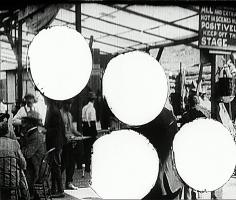
Norbert Pfaffenbichler
MOSAIK MÉCANIQUE
Experimental film | 35mm | black and white | 9:30 | Austria | 2007
SYNOPSIS All the shots of the slapstick comedy ?A Film Johnnie? (USA, 1914) are shown simultaneously in a symmetrical grid, one after the other. Each scene, from one cut to the next, from the first to the last frame, is looped. A pulsing visual polyrhythm is produced as a result, because of the shots? varying lengths. The total length of the mosaic film corresponds precisely to that of the original. ALPHABETIZATION Silent film was in a sense put in written form. The individual images are arranged in chronological order, from left to right and from the top down, in the same way as Latin letters. The entire film can be ?read? as if from a page in a book. REREADING The original film was subjected to a thorough rereading. The original footage was not altered, there was no optical manipulation of the images, and the sequence and length of the shots were maintained. The opening credits, intertitles, the countdown before the film starts, and end credits are of course part of the mosaic. Solely a different, ?panoramic? gaze was directed at the original. This historical grotesque film was in a way analyzed and, as a result, radicalized. SPATIALIZATION This experiment results in a de facto ?spatialization? of the two-dimensional medium. The process according which the original cut was arranged becomes the installation?s structural principle. Editing becomes architecture, and time becomes space. MULTIPLICATION As a result of the simultaneously horizontal and vertical arrangement of the moving images, the spaces and figures from the original film are multiplied. Each shot is turned into a separate chamber in an architectural structure. The fidgeting figures are prisoners caught in their boxes, doomed to never-ending mechanical repetition.
Norbert Pfaffenbichler (* 1967) Study of Mediadesign at the University of Applied Arts, Vienna Exhibitions and Festivals (Selection): 1996 Chromapark, Berlin. 1997 Chichester Film Festival, Chichester; Circles of Confusion, Berlin. 1998 Diagonale, Graz. 1999 viper Videofestival, Basel. 2000 Sonar Festival, Barcelona; Medienturm, Graz. 2001 Underground Film Festival, New York. 2002 Internationales Filmfestival, Rotterdam; Intercultural Videoart Exhibition, Tokio; 59. Filmfestspiele, Venedig; Museum der Wahrnehmung, Graz. 2003 Sound Spectral, O.K Centrum für Gegenwartskunst, Linz; Ars Electronica, Linz. 2006 DIGITAL TRANSIT, ARCO, Medialab Madrid.
Catalogue : 2007Notes on Film 02 | Experimental fiction | betaSP | color and b&w | 96:0 | Austria | 2005
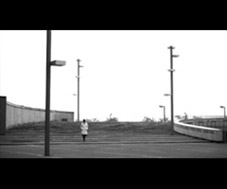
Norbert Pfaffenbichler
Notes on Film 02
Experimental fiction | betaSP | color and b&w | 96:0 | Austria | 2005
In a delusive vision, repetition is based on repetitions, difference is based on differences. Repetitions are repeated, the differentiating elements are differentiated (Gilles Deleuze). This experiment on the themes of 'difference and repetition' combines methods employed in structural film and elements of narrative cinema. Moments from the life of a heterosexual couple were arranged in sequence on the basis of a simple alphanumeric editing concept. Robert Frank?s film "O.K End Here" (USA, 1963) served as a model. This work was evidently greatly influenced by the Italian director Michelangelo Antonioni. Frank attempted to translate Antonioni?s film language to his own environment, the New York of the Beat Generation, in doing so ignoring film conventions to a large extent and producing highly individual visual compositions and sequences of cuts. The motivation to borrow from this work when making "N. o. F. 02" was for one the fact that the original source itself represented an attempt to translate an aesthetic form, and secondly because of its intentional disregard of the conventional rules of filmmaking. Furthermore, "N. o. F. 02" contains additional references to classics of the late Modern. The purpose of this mosaic of references is to question the way in which moving images work.
Norbert Pfaffenbichler was born in 1967. He studied Media Design at the University of Applied Arts, Vienna. His works have been shown at several exhibitions and festivals including: 1996 Chromapark, Berlin; 1997 Chichester Film Festival, Chichester; Circles of Confusion, Berlin. 1998 Diagonale, Graz. 1999 viper Videofestival, Basel; 2000 Sonar Festival, Barcelona, Medienturm, Graz; 2001 Underground Film Festival, New York; 2002 Internationales Filmfestival, Rotterdam; Intercultural Videoart Exhibition, Tokio; 59. Filmfestspiele, Venedig; Museum der Wahrnehmung, Graz. 2003 Sound Spectral, O.K Centrum für Gegenwartskunst, Linz; Ars Electronica, Linz. 2006 DIGITAL TRANSIT, ARCO, Medialab Madrid.
Mario Pfeifer
Catalogue : 2023Cell 5 – A Reconstruction | Documentary | 4k | black and white | 43:0 | Germany, United Kingdom | 2023
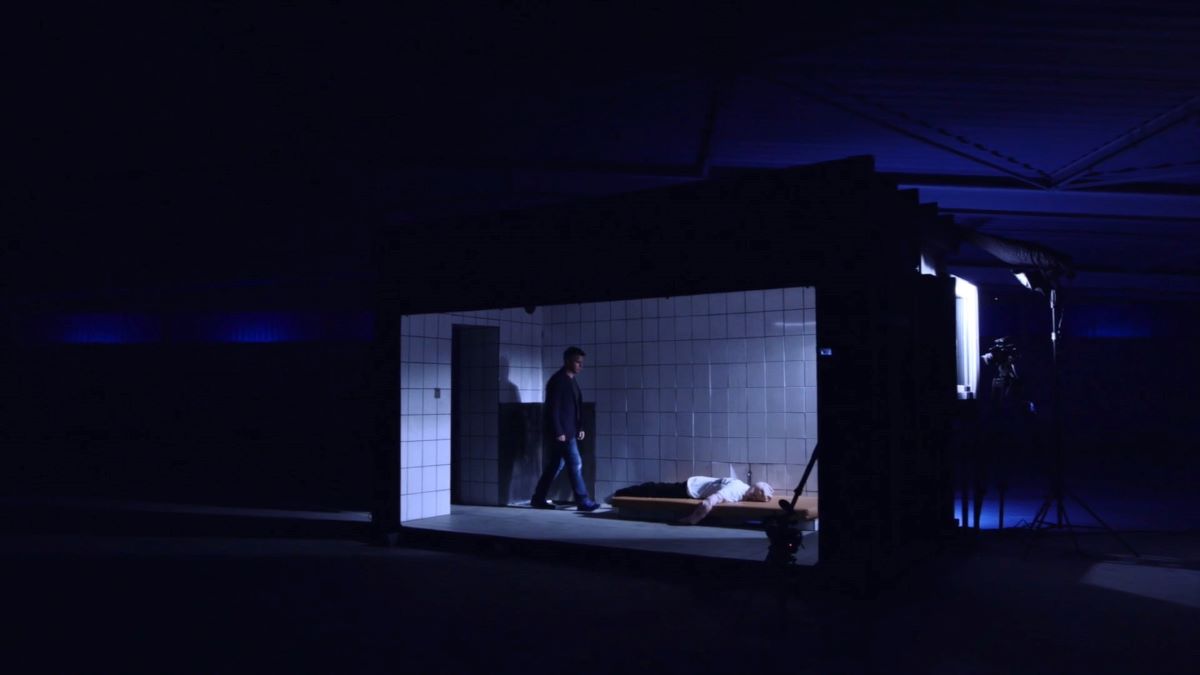
Mario Pfeifer
Cell 5 – A Reconstruction
Documentary | 4k | black and white | 43:0 | Germany, United Kingdom | 2023
On January 7th 2005 an asylum seeker, shackled at his hands and feet, dies in a fire in cell number five of a police station in Dessau, Germany. With “Cell 5” Mario Pfeifer reconstructs the case of Oury Jalloh’s death using legal documents, testimonies, audio-visual archives, and collaborates with the forensic expert Iain Peck to reproduce an accurate fire experiment. All in an attempt to answer: how could Oury Jalloh burn to death?
Mario Pfeifer ist a PRIX EUROPA nominated producer, director and visual artist whose interests intersect between political, social and anthropological issues. Mario works closely with communities, establishing intimate relationships from which he conceives his projects in collaboration with his protagonists. He graduated from the art academy Städelschule in Frankfurt am Main, studied with Stan Douglas at the University of the Arts in Berlin and was a Fulbright scholar in 2008 at the California Institute of the Arts, Mario is a recipient of DAAD fellowships in 2010 and 2012. Mario is an alumni of the European Creator’s Lab (2021), the Documentary Campus Masterschool (2019), the Feature Expanded Masterclass (2017), and a Berlinale Talent Campus alumni (2009). Mario Pfeifer’s installations were presented at the Power Plant Toronto; Museum of Modern Art, Berlin; Los Angeles County Museum of Art [LACMA], Los Angeles; MMK Museum fu?r Moderne Kunst Frankfurt am Main; Bundeskunsthalle Bonn; Neues Museum Nu?rnberg; Kunsthalle Winterthur; N.B.K. Neuer Berliner Kunstverein; Fotomuseum Winterthur; KOW, Berlin; Beursschouwburg, Brussels; MAAT Museum of Art, Architecture and Technology, Lisbon; KW Kunst-Werke, Berlin; CCA,Lagos; and his film presented at international Film Festivals in Amsterdam, Auckland, Berlin, Cologne, London, Madrid, Paris, Oberhausen, New York, Seoul and Toronto. He participated in the 3rd Montevideo Biennal (2016), the 11th Bienal do Mercosul (2018), the 10th Berlin Biennale (2018) as well as the 4th Mediterranean Biennale (2020). His works are hold in public and private museum collections at the Getty Center Los Angeles, Collection of Contemporary Art of the Federal Republic of Germany, Pinakothek der Moderne Munich, MMK Museum of Modern Art Frankfurt am Main, Fotomuseum Winterthur et.al. Mario has lectured and directed Masterclasses in Brazil, Chile, Czech Republic, Germany, India, Mexico, Poland, the U.K. and in the US. www.blackboardfilms.net/people
Mario Pfeifer
Catalogue : 2010UNTITLED [TWO GuYS] | Video | dv | color | 8:0 | Germany | 2008
Mario Pfeifer
UNTITLED [TWO GuYS]
Video | dv | color | 8:0 | Germany | 2008
Synopsis (short): Cast: Cast: Sami Moss Mardina & Yeisen Acosta Medina Crew: Producer: Jakob Schillinger / Mario Pfeifer Cinematograpy: Matthias Biber Monatge: Mario Pfeifer Sound design: Thomas Wallmann Light design: Manuel Kinzer
Mario Pfeifer (b. 1981, Dresden /Germany) is a filmmaking artist based in Berlin and Los Angeles. He studied Fine Art at the Academy of Visual Arts Leipzig, University of the Arts Berlin and Städelschule Frankfurt am Main where he graduated in 2008. On invitation of the ?Bangkok Experimental Filmfestival 5? he co-curated international, artist made films from Berlin for the 2008 festival?s program. Mario Pfeifer was a Fulbright Scholar in California, USA in 2008/2009.
Catalogue : 2010Reconsidering The New Industrial Parks near Irvin | Experimental doc. | 16mm | black and white | 13:0 | Germany, USA | 2009
Mario Pfeifer
Reconsidering The New Industrial Parks near Irvin
Experimental doc. | 16mm | black and white | 13:0 | Germany, USA | 2009
Mario Pfeifer
Catalogue : 2021Again | Noch einmal | Documentary | 4k | color | 40:0 | Germany | 2018
Mario Pfeifer
Again | Noch einmal
Documentary | 4k | color | 40:0 | Germany | 2018
A violent supermarket incident involving a refugee in East Germany is reenacted in a film studio. Ten citizens observe and comment on the case, which highlights the blurred distinction between civil courage and vigilante justice.
Producer / Director Mario Pfeifer's (*1981, Dresden / Germany) films explore representational structures and conventions in the medium of film and video, in locations ranging from Mumbai to New York, from Brazil to the Atacama desert, from Tierra del Fuego to East-Germany to the Western Sahara. He conceives each project out of a specific cultural situation, researches social-political backgrounds and weaves cross-cultural art historical, filmic, technological and political references into a richly layered practice.
Désirée Pfenninger
Catalogue : 2015Ochs am Berg | Fiction | 16mm | color | 15:48 | Germany | 2014
Désirée Pfenninger
Ochs am Berg
Fiction | 16mm | color | 15:48 | Germany | 2014
A rest stop docks the highway like a moonbase. Within this transit space a young man and a young woman drift in their orbits. A German love story.
After her first steps in the movie industry Désirée decided not to study film. After finishing studies in photo engineering and further filmexperiments she signed up for directing classes in Paris and Potsdam.
Lan Pham Ngoc
Catalogue : 2013Chuyen Moi Nha | Experimental doc. | dv | color | 9:17 | Vietnam | 2011
Lan Pham Ngoc
Chuyen Moi Nha
Experimental doc. | dv | color | 9:17 | Vietnam | 2011
Utilizing the banality of Vietnamese state radio broadcasts, The Story of Ones gives a face and a sense of place to the unseen and offers a personal counterpoint to the officially sanctioned. Like entering a roomful of stories, the viewer steps into an unfamiliar space guided only by the sound of the radio tuning in to lifestyle programming, call-in shows and radio dramas. The portraits and settings layered atop the aural landscape create questions, provide humor, offer context and withdraw explanation of what once seemed clear before entering the room.
Pham Ngoc Lan {Phạm Ngọc Lân} was born in Hanoi, Vietnam; in July 02, 1986. He studied urban design and urban planning from 2004 to 2009 at Hanoi Architecture University (HAU). Inspired by the paradox of all living things, Lan considers himself an urban life observer rather than a photographer or an urban designer. Using photography and film as two of the favorite tools to express his ideas, his work attaches special importance to the direct, poetic and especially the whimsical respects of human life.
Paulette Phillips
Catalogue : 2009Marnie's Handbag | Art vidéo | dv | color and b&w | 10:0 | Canada | 2008
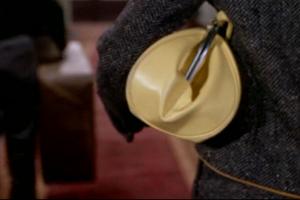
Paulette Phillips
Marnie's Handbag
Art vidéo | dv | color and b&w | 10:0 | Canada | 2008
Marnie?s Handbag is a mash-up focused on the female criminal in popular cinema. Phillips takes a historical look at how Hollywood paradoxically dresses the female felon as she attempts to avoid apprehension. Looking at sequences of women dressing to commit a crime, removing the women from their narrative context Phillips focuses on the pleasure we derive from unbridled seduction and evening the score.
Paulette Phillips? recent group exhibitions include: The Tatton Park Biennale, UK; The Canadian Cultural Centre, Paris; The Power Plant, Toronto; ZKM, Germany; Kunsthaus Graz, Austria; Heidelberger Kunstverein, Germany, Ludwig Museum, Hungary and the Palazzo della Papesse, Italy. Reviews of her recent work can be found in Art in America, ArtForum, Modern Painters and Flashart. Based in Toronto, Phillips? work is represented by Diaz Contemporary Art, Toronto and Danielle Arnaud contemporary art, London. She teaches at The Ontario College of Art and Design.
Cristina Picchi
Catalogue : 2015Zima | Experimental doc. | hdv | color | 11:27 | Italy, Russia | 2013
Cristina Picchi
Zima
Experimental doc. | hdv | color | 11:27 | Italy, Russia | 2013
A portrait of a season - a journey through North Russia and Siberia, through the feelings and thoughts of the people who have to cope with one of the world's harshest climates; a reality where the boundary between life and death is so thin that is sometimes almost nonexistent, where civilization constantly both fights and embraces nature and its timeless rules and rites. In these remote places, people, animals and nature itself become elements of a millennial yet unpredictable script, in which physical and mental endurance play an important role as much as chance does, where life and death constantly embrace each other. A reflection on fate, adaptation and the immutable cycles of existence.
Cristina Picchi (Lucca, 1981) is an award winning Italian filmmaker, writer and artist based in London. As a filmmaker she has directed and edited the short documentaries Zima (2013), Eyes On The Ground (2012), Under Your Skin (2011), Fragments of a Dream (2011) and The Disassociated (2011); her films have been screened in festivals and galleries worldwide. Her written work includes short stories and contributions to award-winning books. She holds a degree and an MA in European Literature from the University of Pisa and and a master`s degree in Screen Documentary from Goldsmiths University.
Stéphane Pichard
Catalogue : 2016Fécampoise | Video | hdv | color | 2:49 | France | 2015
Stéphane Pichard
Fécampoise
Video | hdv | color | 2:49 | France | 2015
FECAMPOISE réuni plusieurs notes qui peuvent-être vues indépendamment ou par assemblage, vous verrez ici « J`ai pourtant bien essayé de te voir » et « Dites-moi que je rêve ». FECAMPOISE est un « docu-fanfare » comme on dit « docu-fiction », une sorte de comédie musicale. Voir les couvertures de survies -« Sound of music » (Y. Duyvendak)- qui dégringolent du plafond poussant les danseurs vers le quatrième mur jusqu`à ne plus pouvoir danser. Fin. Nous incluant, fin. Comme ces gens -« La fièvre dans le sang » (E. Kazan)- qui en 29, à Wall Street, se jetaient des tours. J`ai pourtant bien essayé de te voir.
Stéphane Pichard est né en 1968 à Nanterre. Diplômé en 1993 de l’ENSBA de Paris, il continue ses études à l’University of British Columbia dans le programme Master of Fine Arts, à Vancouver Canada, puis poursuit ses recherches à Paris VIII et à l’INA. Stéphane Pichard vit et travaille à Paris.
Catalogue : 2007Comme de jour | Art vidéo | dv | color | 1:55 | France, Mali | 2006
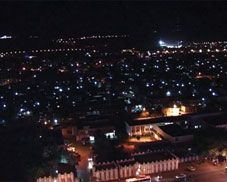
Stéphane Pichard
Comme de jour
Art vidéo | dv | color | 1:55 | France, Mali | 2006
Let's start by closing our eyes. The 4/3 vertically divided screen teems with black and white pixels. There is something intense that we confusingly perceive in the breath and the noise. Progressively the pixels are going to diminish, most likely in favour of the little scene of a character. It is a short-cut and an extraction, a numeric zoom becoming optics, always in the rear. Like a vast inspiration, the city of Bamako grows at night, its lungs filled with heat and dust. " ...The picture is the result of an operation whose viewing is an instrument and not the preamble."* *Philippe-Alain Michaud, Sketches, page 67, Kargo and L'Eclat editions.
Stéphane Pichard was born in Nanterre in 1968. In 1993 he graduated from the ENSBA in Paris. He continued his studies at the University of British Columbia, Vancouver, Canada, completing a Master in Fine Arts. He then pursued research at Paris VIII and at the INA. He subsequently participated in several exhibitions in France and abroad. As a professor of plastic arts, he developed the residency program "Synapse" at the ESA in Rueil-Malmaison.
Catalogue : 2006Répétition pour caméra et tablas | Art vidéo | 0 | color | 3:0 | France | 2005
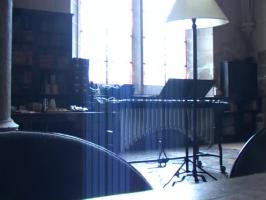
Stéphane Pichard
Répétition pour caméra et tablas
Art vidéo | 0 | color | 3:0 | France | 2005
Leighton Pierce
Catalogue : 2022Everything s gonna be OK | Video | 4k | color | 6:37 | USA | 2021
Leighton Pierce
Everything s gonna be OK
Video | 4k | color | 6:37 | USA | 2021
This is a part of a developing series titles UAP (Unidentified Arial Phenomena). Looking to the sky can reveal both threats and salvation. This was shot and edited on a phone and is intended eventually to be presented on the intimate format of a phone. Shot and edited in summer 2021.
Pierce has been making films, video, and installations for over 3 decades with screenings at Cinematheque francais, Pompidou Center, Sundance, NYFF, Rotterdam, EMAF ad many other venues. Among others, he is recipient of Guggenheim, Rockefeller, and Creative Capital Fellowships. For the past 8 years he has been living in LA where he was dean and is now faculty at CalArts.
Romain Pierre
Catalogue : 2014Taverne Française | Fiction | hdv | color | 7:23 | France | 2013
Romain Pierre
Taverne Française
Fiction | hdv | color | 7:23 | France | 2013
Taverne Française est d`abord un espace, physique et social, comprenant des murs et des possibles. Son vocabulaire pourrait être d`aujourd`hui, sa musique d`hier, son énergie celle de la jeunesse. Ce n`est pourtant pas l`analyse d`une époque ni le portrait d`une génération. Peu importe la taverne, c`est une taverne : on y sent l`urine, l`alcool et la sueur, on y parle de désir et de mort. Il ne pourrait pas s`agir d`autre chose, car c`est précisément toutes les autres choses qui sont en jeu. Les corps ne connaissent pas d`histoires ; la seule histoire s`inscrit entre les corps. Dès lors qu`il n`y a plus de jugements de valeur, le besoin ne se distingue pas de l`ennui, ni la cruauté de la tendresse, et dans ce délire, sans humour ni gravité, se trame le délire du monde. On ne délire pas sur une affaire personnelle mais, comme le dit Deleuze de l`inconscient, "sur les races, les tribus, les continents, l`histoire et la géographie, toujours un champ social". Et la parole de corps désaffectés, si elle n`est pas la parole des morts, ressemble bien à celle de l`inconscient.
Romain Pierre est né en 1989 à Paris. Il suit une formation de comédien à l`école supérieure d`art dramatique du Théâtre National de Strasbourg. En 2013, il écrit et réalise son premier court-métrage, Taverne Française, inspiré de l`oeuvre de Georges Bataille et des Velvet Underground.
Vaughan Pilikian
Catalogue : 2009Household Gods | Experimental fiction | 16mm | color | 6:30 | United Kingdom | 2008
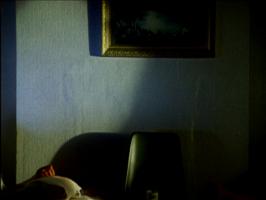
Vaughan Pilikian
Household Gods
Experimental fiction | 16mm | color | 6:30 | United Kingdom | 2008
Alone at home, but haunted by other voices: six people is six rooms somewhere in London.
Vaughan Pilikian is a writer, director and artist who lives in London. His short films have screened in festivals around the world, and he is currently at work on his first feature.
Joana Pimenta
Antoni Pinent
Catalogue : 2010FILM QUARTET / POLYFRAME | Experimental film | 35mm | color and b&w | 9:0 | Spain | 2008
Antoni Pinent
FILM QUARTET / POLYFRAME
Experimental film | 35mm | color and b&w | 9:0 | Spain | 2008
FILM QUARTET / POLYFRAME is conceived as a small cinematographic bomb attempting to question the established definition of frame as the minimum unit of (cinematographic) time by dynamiting it in four fragments. A step further in the so-called sub-genre practice of found footage film -recycled material- is also put forward for consideration in this project. The appropriationism applied in this work makes use of material found in Hollywood cinema (Singin?in the rain, Stanley Donen, 1952); Pink Panther; Buster Keaton; etc., the first avant-garde period (Un chien andalou, Luis Buñuel & Salvador Dalí, 1929) and American experimental film (Wavelength, Michael Snow, 1966-1967). Such method makes possible, therefore, to maintain image ecology while it provides an analysis of the history of cinema. An explosive artifact has been inscribed as cinematographic notation on musical staffs in order to facilitate the interpretation and development of the piece beyond its mere projection. Such being the case, unchanging cinematographic would pushed for their reinvention-destruction-explotion. This piece celebrates the 50th anniversary of A Movie (1958), by Bruce Conner (1933-2008).